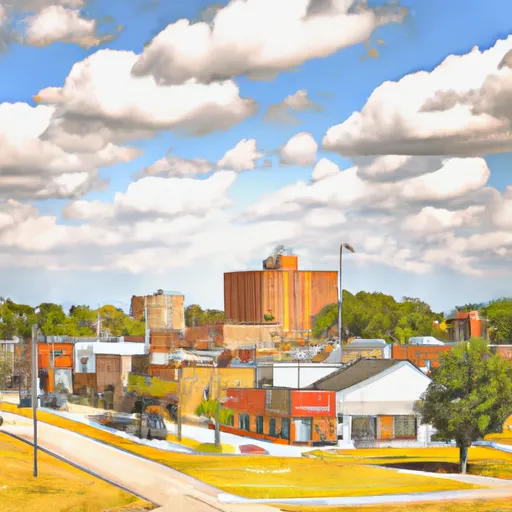-
 Snoflo Premium
Snoflo Premium
Get unlimited access to all our content
With no Ad interruptions! - Start Your Free Trial Login with existing account
Ionia
Eden Index
Climate
8.2
•
Recreation
4.8
•
Community
•
Safeguard
5.0/10

Ionia, Kansas is a small town located in Jewell County in the central part of the state. With a population of less than 100 residents, it offers a peaceful and close-knit community.
Ionia experiences a typical continental climate, characterized by hot summers and cold winters. Average high temperatures in summer reach the mid-80s (°F), while winter lows can drop to around 20°F. Precipitation is evenly distributed throughout the year, with an annual average of around 30 inches.
The town's hydrology constituents are primarily influenced by nearby Buffalo Creek, which flows through the area. This waterway provides opportunities for fishing enthusiasts to catch a variety of fish species, including bass and catfish.
Outdoor recreation opportunities in Ionia include exploring the beautiful countryside with various walking and hiking trails. The town's proximity to Webster State Park, just a short drive away, provides additional recreational activities such as boating, swimming, camping, and wildlife watching. Nature lovers can enjoy the serene surroundings and spot a variety of bird species. The quiet and picturesque environment offers visitors and residents a chance to unwind and connect with nature.
What is the Eden Index?
The Snoflo Eden Index serves as a comprehensive rating system for regions, evaluating their desirability through a holistic assessment of climate health, outdoor recreation opportunities, and natural disaster risk, acknowledging the profound impact of these factors on livability and well-being.
Climate Health Indicator (CHI): 8.2
Ionia receives approximately
681mm of rain per year,
with humidity levels near 81%
and air temperatures averaging around
12°C.
Ionia has a plant hardyness factor of
6, meaning
plants and agriculture in this region thrive during a short period during spring and early summer. Most
plants will die off during the colder winter months.
By considering the ideal temperature range, reliable water supplies, clean air, and stable seasonal rain or snowpacks, the Climate Health Indicator (CHI) underscores the significance of a healthy climate as the foundation for quality living.
A healthy climate is paramount for ensuring a high quality of life and livability in a region, fostering both physical well-being and environmental harmony. This can be characterized by ideal temperatures, reliable access to water supplies, clean air, and consistent seasonal rain or snowpacks.
Weather Forecast
Streamflow Conditions
Republican
Area Rivers
Republican
Snowpack Depths
Republican
Reservoir Storage Capacity
Republican
Groundwater Levels
Recreational Opportunity Index (ROI): 4.8
The Recreational Opportunity Index (ROI) recognizes the value of outdoor recreational options, such as parks, hiking trails, camping sites, and fishing spots, while acknowledging that climate plays a pivotal role in ensuring the comfort and consistency of these experiences.
Access to outdoor recreational opportunities, encompassing activities such as parks, hiking, camping, and fishing, is crucial for overall well-being, and the climate plays a pivotal role in enabling and enhancing these experiences, ensuring that individuals can engage in nature-based activities comfortably and consistently.
Camping Areas
| Campground | Campsites | Reservations | Toilets | Showers | Elevation |
|---|---|---|---|---|---|
| Mormon Island State Rec Area | 38 | 1,885 ft | |||
| Glen Elder State Park | 425 | 1,470 ft | |||
| Bader Memorial Park | 31 | 1,767 ft | |||
| Jewell State Fishing Lake | None | 1,684 ft | |||
| Streeter Municipal Park | 18 | 1,760 ft | |||
| George Clayton Hall County Park | None | 1,864 ft | |||
| Tooley Park | 5 | 1,733 ft | |||
| DLD State Wayside Rec Area | None | 1,898 ft |
Catastrophe Safeguard Index (CSI):
The Catastrophe Safeguard Index (CSI) recognizes that natural disaster risk, encompassing floods, fires, hurricanes, and tornadoes, can drastically affect safety and the overall appeal of an area.
The level of natural disaster risk in a region significantly affects safety and the overall livability, with climate change amplifying these risks by potentially increasing the frequency and intensity of events like floods, fires, hurricanes, and tornadoes, thereby posing substantial challenges to community resilience and well-being.
Community Resilience Indicator (CRI):
The Community Resilience Indicator (CRI) recognizes that education, healthcare, and socioeconomics are crucial to the well-being of a region. The CRI acknowledges the profound impact of these elements on residents' overall quality of life. By evaluating educational resources, healthcare accessibility, and economic inclusivity, the index captures the essential aspects that contribute to a thriving community, fostering resident satisfaction, equity, and social cohesion.

